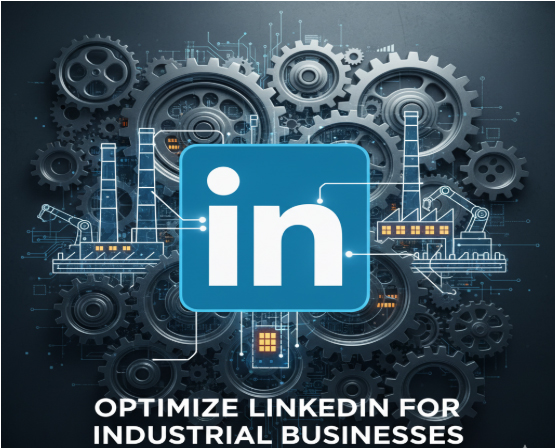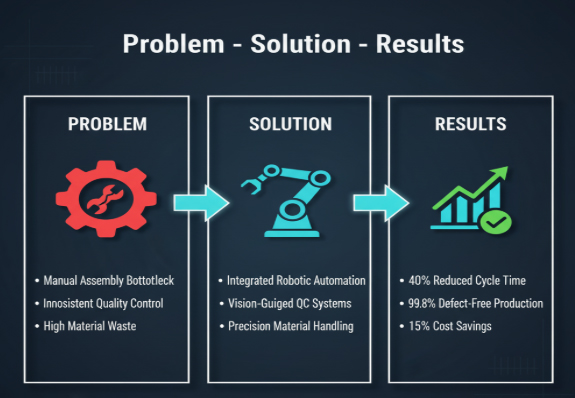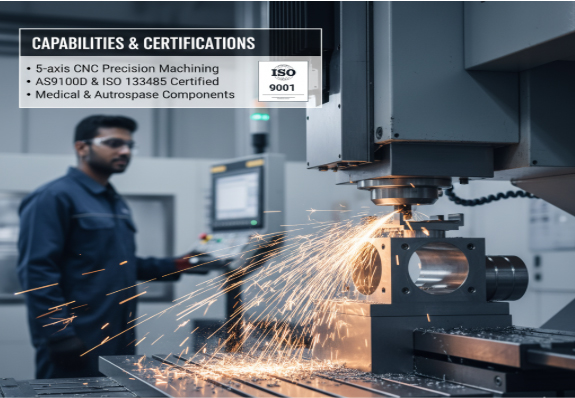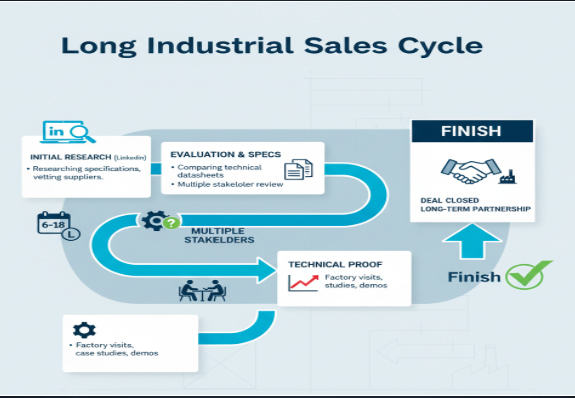How to Optimize LinkedIn for Industrial Businesses

LinkedIn isn’t just another social platform for industrial companies, it’s where 92 million manufacturing professionals research solutions, vet suppliers, and make buying decisions.
Table of Contents
- Start with a company page that showcases real capabilities
- Position your executives as technical authorities, not generic business leaders
- Create Content That Technical Buyers Actually Want
- Target and Connect with the Right Industrial Buyers
- Use LinkedIn advertising when targeting justifies the cost
- LinkedIn Lead Generation Forms: Use Strategically
- Measure what matters for long-cycle industrial sales
- Start with these priorities
But here’s what matters: Your buyers are engineers who demand technical proof, procurement managers navigating 12-month purchase cycles, and plant managers who care about uptime and ROI. This guide cuts through the noise to show exactly how industrial companies should use LinkedIn to reach technical buyers, demonstrate capabilities, and drive real business results.
Industrial buyers use LinkedIn differently than other B2B audiences. They’re researching specifications, comparing suppliers, and seeking proof of reliability long before they ever fill out a contact form. Your LinkedIn presence needs to reflect the complexity and technical rigor of what you sell.
Start with a company page that showcases real capabilities
Industrial buyers evaluate your LinkedIn page the same way they evaluate your manufacturing floor: looking for evidence of capability, quality, and reliability.
Complete every section with industrial-specific details. In your “About” section, lead with your core capabilities and technical specializations, not marketing fluff.
Example: “Precision machining for aerospace and medical devices. AS9100D and ISO 13485 certified. 5-axis CNC capabilities with ±0.0001″ tolerances.” This immediately signals expertise to technical buyers.
Your company tagline should communicate what you make or do, not vague positioning statements.
“Innovative Manufacturing Solutions” does not tell buyers much. Instead, use something specific like “Industrial Automation Systems for Food Processing Plants”. This is clear, easy to search for, and meaningful.
Use keywords that your prospects actually search for: automation, fabrication, precision machining, industrial coatings, or whatever fits your business.
Show your facility, equipment, and certifications on your LinkedIn page. Upload high-quality photos of your manufacturing floor, machinery, and finished products. Industrial buyers want to see what you can do, not stock photos of people in business suits. Display your quality certifications clearly, such as ISO 9001, AS9100, IATF 16949, or any important industry credentials. These certifications are very important to technical buyers.
Update your call-to-action button thoughtfully. For most industrial companies, “Visit Website” is the best choice. This sends visitors to technical resources like product specs, case studies, and capability statements that LinkedIn cannot host easily.
“Showcase your capabilities and certifications with clear photos and specific keywords. Make it easy for industrial buyers to find technical information about your business.
Position your executives as technical authorities, not generic business leaders”
Position your executives as technical authorities, not generic business leaders
Here’s your refined content, optimized for readability, with bolded highlights and no em dashes:
In industrial sales, personal credibility is essential for building strong business relationships. When a plant manager considers a major equipment purchase, they want to connect with people who understand their technical challenges, not someone with a generic headline like “CEO at Company X.”
Executives’ LinkedIn headlines should clearly show technical expertise and industry knowledge. Instead of “President at ABC Manufacturing,” use a headline like “Precision Machining Expert | Aerospace and Medical Manufacturing | 25 Years Solving Complex Tolerance Challenges.” This builds credibility and uses important keywords.
The “About” section should highlight technical accomplishments and industry experience. Mention patents, certifications, speaking events at industry conferences, and specific problems you have solved. Technical buyers trust people with a strong technical background, so showcase your expertise.
Professional headshots are important, but authenticity is even more valuable. In the industrial sector, a photo of an executive on the shop floor shows hands-on involvement and a true understanding of the work.
Executives should post thought leadership content regularly. Focus on technical insights, industry trends, manufacturing challenges, new technologies, or regulatory changes. Add meaningful comments to industry discussions. When prospects research your company, they will see leaders who truly understand the business and gain instant credibility.
In industrial sales, personal credibility is key. Use LinkedIn headlines that show real technical expertise, not just job titles. Feature technical accomplishments, patents, and certifications in your “About” section. Use authentic photos; shop floor shots work better than studio portraits. Share useful, technical insights and industry trends to demonstrate your knowledge and earn trust from buyers.
Create content that technical buyers actually want to see
Most LinkedIn content advice doesn’t work for industrial companies because it targets audiences who like thought leadership quotes and business tips. Engineers want to see how things work. Procurement managers want proof of reliability. Plant managers want real solutions to specific problems.
What works for industrial B2B:
- Behind-the-scenes manufacturing content performs exceptionally well. Short videos of machining operations, welding processes, or quality inspections fascinate technical audiences. For example, a 30-second video of a 5-axis CNC machining a complex part will get more engagement from your target buyers than any motivational quote. Show your capabilities in action.
- Problem-solution case studies connect strongly. Use this format: “Customer had [specific technical problem]. Here’s how we solved it with [specific solution]. Results: [measurable outcomes].” Keep it concise—3 to 4 paragraphs maximum. Specifics like “Reduced cycle time by 40% while maintaining ±0.001″ tolerances”are much more compelling than “delivered exceptional results.”

- Application stories and technical tips provide ongoing value. Share posts explaining how to select the right material, common mistakes in equipment specification, or maintenance best practices. This shows you are a helpful technical resource, not just a vendor. Share the practical knowledge your team uses every day.
- Announce new equipment, capabilities, or certifications. When you add a new machine, earn a certification, or expand capabilities, share it. These posts signal growth and reliability to your prospects.
What to avoid: Do not post motivational quotes, generic business advice, overly promotional content, or anything that could fit any industry. If your post would also work for a software company or consulting firm, it is wrong for your industrial audience.
Consistency and quality matter more than frequency. Three valuable posts per week are better than daily generic ones. LinkedIn rewards posts with early engagement, so post during business hours—Tuesday to Thursday, between 7 and 10 AM works best for industrial audiences. Have your team like and comment within the first hour.
LinkedIn favors native content over links. Instead of just sharing a link, repost the full content on LinkedIn as an article or use the “see more” format for longer updates. Put your website link in the comments.
Use 3 to 5 relevant, industry-specific hashtags like **#manufacturing #industrialautomation #precisionmachining #cnc #qualitycontrolThis increases discoverability without looking spammy.
Target and connect with the right industrial buyers
Here’s your rewritten, highly readable version with important points in bold and no em dashes:
Industrial sales cycles take months, not days. Your LinkedIn strategy needs to reflect this reality. Focus on building relationships and staying visible throughout long evaluation periods, not chasing quick sales.
LinkedIn Sales Navigator is essential for industrial companies with active sales teams. For about $80-100 per month per user, you get advanced search capabilities missing from free LinkedIn: filter by company size, industry, geography, job title, and seniority. You can save accounts and contacts in lists, get lead recommendations, and see who’s viewed your profile. For companies selling complex products with long sales cycles, Sales Navigator often pays for itself by saving research time and improving lead targeting.
Target by job function, not just title. Purchasing Director, Plant Manager, Engineering Manager, Operations Director, Maintenance Manager—industrial purchases involve several stakeholders. Build connections across the entire buying committee, not just with one contact.
Personalize every connection request. Mention something specific like a mutual connection, a company’s recent expansion, an industry challenge, or shared group membership. Never pitch your product in the connection request. Your goal is to get into their network so your content appears in their feed over the next 6 to 12 months as they evaluate solutions.
Join LinkedIn groups relevant to your industrial niche. Groups for manufacturing processes, industry verticals (automotive, aerospace, food processing), or regional manufacturing associations provide access to concentrated audiences of ideal prospects. Participate genuinely—answer questions, share insights, and contribute value.
Integrate LinkedIn with trade shows and industry events. Before an event, connect with registered attendees. After meeting prospects at your booth, connect within 24 hours while you’re still fresh in their mind, and mention the show. Trade shows start the relationship; LinkedIn helps you maintain it during the long sales cycle.
For companies with distributor networks, train distributors and reps on LinkedIn. Their local connections and technical expertise, combined with consistent LinkedIn activity, extend your reach in regional markets that your direct sales team can’t easily cover.
Use LinkedIn advertising when targeting justifies the cost
Here’s your revised content, optimized for readability with important points in bold and no em dashes:
LinkedIn advertising costs more than other platforms, typically $8-15 per click for industrial audiences. It’s worth it when precise targeting matters more than sheer volume. For companies selling high-value industrial products to specific buyer personas, this targeting can justify the premium.
Sponsored content delivers the best results for industrial advertisers. These native ads show up in users’ feeds alongside organic content and are less intrusive than traditional display ads.
- Single image ads are ideal for product announcements or thought leadership pieces.
- Video ads work well for equipment demonstrations or facility tours.
- Document ads are effective for promoting technical whitepapers or case studies.
Use LinkedIn’s B2B targeting filters for maximum precision:
- Job function: Operations, Purchasing, Engineering, Quality
- Seniority level: Director, VP, Manager
- Company size: By employee count or revenue
- Industry: With detailed sub-industry options
- Geography: Regional or location-specific
By layering these filters, you can target audiences like “Engineering Managers at companies with 500-1,000 employees in the automotive industry in the Midwest” for highly relevant ads.
For industrial B2B, start with a $1,000-2,000 monthly ad budget minimum to gather enough data. Expect to pay $50-150 per lead for basic contact info, and $200-400 per MQL (Marketing Qualified Lead) with real buying intent. This can seem expensive, but if your average deal value is $100,000 or more and you’re reaching decision-makers, the ROI is strong.
Custom audiences often deliver exceptional results. Upload your customer or prospect lists (minimum 300 contacts) to create a Matched Audience, then build lookalike audiences to find similar prospects. Retarget website visitors, especially those who view your product specification or case study pages.
LinkedIn Lead Gen Forms are convenient because they autofill user data, which reduces friction. However, they may produce lower-quality leads. For high-value industrial sales, directing prospects to a landing page with more qualification steps often gives you better leads, even if the conversion rate is lower.
Set clear expectations: LinkedIn advertising is mainly a top-of-funnel and nurture tool for industrial companies. The focus is on building awareness and relationships, not quick sales.
Track cost per lead and website visits, but also measure how ads affect your pipeline and revenue over the next 6 to 12 months.
LinkedIn Lead Generation Forms: Use Strategically
LinkedIn delivers 2-5x higher ROAS than other social platforms for B2B, according to Demand Sage. Lead Gen Forms are a major reason why.
How they work: When prospects click your ad, a form auto-fills with their LinkedIn profile data—name, email, company, job title. One click to submit, zero typing required. Available for sponsored content and messaging campaigns.
The trade-off for industrial companies: Ultra-low friction generates more leads but often lower quality. When someone can submit with one click, you get volume over intent.
Use Lead Gen Forms for:
- Technical guides, whitepapers, spec sheets (top-of-funnel content)
- Trade show follow-up campaigns (warm audiences)
- Retargeting website visitors (demonstrated interest)
Use traditional landing pages for:
- High-value equipment quotes ($50K+)
- Custom solution requests
- Demo or consultation bookings
Landing pages with 3-4 qualifying questions produce fewer leads but higher-quality prospects for complex industrial sales. For $250K CNC machine purchases, you want qualified inquiries, not curiosity clicks. Test both approaches and measure lead-to-opportunity conversion, not just form submissions.
Measure what matters for long-cycle industrial sales
Vanity metrics like follower counts and post impressions don’t pay invoices. Track metrics that connect LinkedIn activity to actual business outcomes.
For organic efforts, monitor:
- Profile views and search appearances (indicates visibility to prospects actively researching)
- Engagement rate on posts (likes, comments, shares relative to followers)
- Connection growth among target personas (not just total connections)
- Inbound messages from prospects (clear intent signal)
- Website traffic from LinkedIn (Google Analytics, filtered by LinkedIn referral)
For paid campaigns, track:
- Cost per click and click-through rate (efficiency metrics)
- Cost per lead and lead volume (top-of-funnel)
- Lead quality scores (how many meet ICP criteria)
- Form completion rate (conversion efficiency)
Most importantly, track pipeline and revenue attribution. In your CRM, tag leads with “LinkedIn” as source and track their progress. For industrial companies with long sales cycles, expect 6-18 months from first LinkedIn interaction to closed deal. Calculate customer acquisition cost and lifetime value to determine true ROI.
Realistic benchmarks for industrial B2B: Good organic engagement rates range from 2-5% (likes, comments, shares divided by impressions). Company page follower growth of 10-20% annually is solid for niche industrial companies. For paid ads, click-through rates of 0.4-0.6% and conversion rates of 2-4% on landing pages indicate effective campaigns.
Set expectations appropriately: LinkedIn is a long-game platform for industrial businesses. It builds brand awareness, establishes thought leadership, and maintains visibility throughout extended sales cycles. Companies that post consistently for 6+ months while simultaneously running targeted ad campaigns see the best results.
Start with these priorities
LinkedIn delivers real value for industrial companies, but only when you treat it as a technical showcase and relationship-building platform, not a social network. Your buyers are there, researching suppliers and vetting options long before they contact anyone.
Start here:
- Optimize your company page and executive profiles with technical, industrial-specific content today—this costs nothing and takes a few hours
- Begin posting 2-3 times per week with behind-the-scenes manufacturing content, problem-solving tips, and capability demonstrations
- If you have active sales teams, invest in Sales Navigator and train them to build connections systematically
- Once organic presence is established, test small paid campaigns ($1-2K/month) targeting your most valuable buyer personas
Remember: In industrial sales, LinkedIn’s value compounds over time. The plant manager who follows your page in March might not request a quote until November. Your consistent presence, technical credibility, and helpful content keep you top-of-mind throughout their entire evaluation process. That’s exactly how industrial buying decisions happen—and why LinkedIn, done right, drives real business results for manufacturing, construction, and engineering companies.



